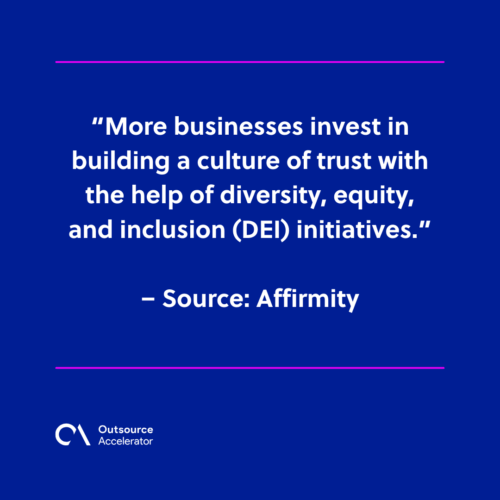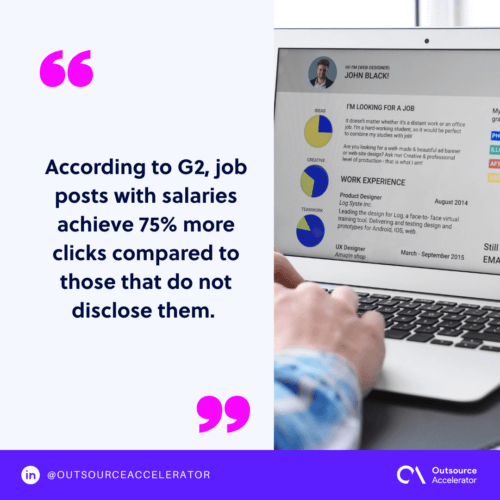The ultimate recruitment statistics and trends to watch out for in 2025

Like in most business aspects, recruitment continuously changes with the shift in technology, demographics, and employee demands.
As we look ahead to 2025, companies must understand the latest recruitment statistics and trends to stay ahead in the competitive job market.
In this comprehensive article, we will delve into the challenges faced in recruitment, the factors that shape recruitment today, and the ultimate recruitment statistics to watch out for in 2024.
Recruitment statistics 2025
“70% of firms perform their recruitment and onboarding processes half-virtual, while one in 10 went on a full virtual option.”
– Source: Monster
“Most of Glassdoor’s monthly user visits come from mobile devices.”
– Source: Glassdoor
“79% of US workers want more than financial benefits at work.”
– Source: Buck
“According to 72% of recruiters employer branding highly impacts hiring.”
– Source: LinkedIn
“More businesses invest in building a culture of trust with the help of diversity, equity, and inclusion (DEI) initiatives.”
– Source: Affirmity

“75% of US employers have difficulty hiring talent, with job vacancy rates reaching 10.7 million openings.”
– Source: Talent Board
“Around 78% of candidates feel frustrated more with not hearing back after sending an application compared to ‘being ghosted after a first date.’”
– Source: Ladders
“Job boards produce 72% of overall applications. However, 22% of applicant hires come from referrals, and only 1% come from these boards.”
– Source: CareerPlug
“Job posts with salaries achieve 75% more clicks compared to those that do not disclose them.”
– Source: G2
“The majority of HR leaders surveyed (73%) already use AI for recruitment and hiring. 41% of them, meanwhile, express their interest in using this tool in the future.”
– Source: Eightfold AI
Challenges faced in recruitment
Modern recruitment is challenging for both recruiters and job seekers. Most applicants find job seeking the most stressful part of employment, while recruiters find attracting and hiring top talent difficult.
These challenges appear although millions of jobs are left open.
Here are four significant challenges in recruitment:
Challenge #1: Talent shortage
One of the most prominent challenges recruiters face is the shortage of qualified candidates for open positions.
In a competitive job market, the demand for specific skills often outweighs the available supply, leaving companies struggling to fill critical roles.
Challenge #2: Diversity and inclusion
Achieving diversity and inclusion in recruitment remains a persistent challenge.
Companies strive to attract candidates from diverse backgrounds. However, unconscious biases, lack of diversity in applicant pools, and inclusive recruitment practices still need to be addressed.
Challenge #3: Evolving technology
Technology continues to transform the recruitment landscape as new tools and platforms emerge.
AI-powered recruitment tools, automated screening systems, and online job platforms have revolutionized how organizations hire.
Embracing these advancements while adapting to the changing technology landscape is crucial for companies seeking to optimize their recruitment processes. It ensures they do not fall behind competitors.
Challenge #4: Employer branding
Establishing a strong employer brand is becoming increasingly vital as candidates place greater importance on workplace culture and values.
Organizations must cultivate a positive employer brand reputation to attract top talent. This includes showcasing company culture, highlighting employee testimonials, and effectively communicating the value proposition to potential candidates.
What factors shape recruitment today
On the bright side, the changing recruitment landscape gives organizations a chance to improve their ways of hiring the best talents.
Here are four key factors shaping recruitment in 2024:
Remote work
Remote work has gained significant momentum recently. Embracing remote work as a viable option allows companies to tap into a wider talent pool by eliminating geographical barriers.
It also allows organizations to reduce costs associated with office space while offering employees flexibility that aligns with their work-life balance preferences.
Candidate experience
A positive and well-designed candidate experience enhances the employer brand and increases the likelihood of successful candidate conversion.
Organizations must focus on delivering personalized and efficient experiences throughout the recruitment process, from application to onboarding.
Data-driven recruitment
Data-driven recruitment uses analysis and insights to drive hiring decisions.
Data-driven approaches help identify recruitment trends, target talent sources more effectively, and improve hiring outcomes.
By leveraging analytics and metrics such as time-to-hire, cost-per-hire, and quality-of-hire, organizations can make informed decisions to optimize their recruitment processes.
Skills-based hiring
In today’s highly competitive job market, skills-based hiring is gaining prominence over traditional qualifications. Employers are prioritizing specific skills and competencies during the hiring process.
Assessing candidates based on their skill sets allows organizations to identify individuals who can immediately contribute to their teams and adapt to rapidly changing business dynamics.
Ultimate recruitment statistics in 2024
The following recruitment statistics provide valuable insights into the trends shaping the hiring landscape:
Virtual recruitment
Virtual recruitment is here to stay.
Boosted by the pandemic, virtual recruitment became an alternative to traditional hiring processes, given the restrictions set worldwide.
Job site Monster revealed that around 70% of companies do their recruitment and onboarding processes half-virtual, while one in 10 went on a full virtual option.
Now, recruiters find it a better option when hiring both office and remote workers. Firms are expected to continue combining in-person and virtual recruitment to get hybrid workers.
Mobile job seeking
Apart from hiring methods, experts also see changes in the platforms job seekers use to look for work.
Glassdoor’s statistics showed that more than half of 67 million monthly visitors use mobile devices to access the site. The mobile platform has become increasingly important for most users as social recruiting becomes more popular.
Demand for employee perks
Now is the time to look for ways to attract and retain employees through benefits and perks.
According to Buck’s Wellbeing and Voluntary Benefits report, 79% of workers in the US want more than financial benefits at work.
Perks such as medical coverage, paid time off, and performance bonuses can impact employee retention in their workplace and the employment opportunities available to them.
Employer branding
Apart from established names, a company’s reputation shapes how its industry, stakeholders, competitors, and even employees see it.
LinkedIn’s 2021 Employer Brand Statistics revealed that 72% of recruiters agree employer brand impacts hiring. It also has the power to attract the right talent who share a similar vision with the company.
This is why global organizations try to build their reputation and work culture based on caring for their employees.
Diversity, equity, and inclusion (DEI)
In line with the employer brand, more businesses invest in building a culture of trust with the help of diversity, equity, and inclusion (DEI) initiatives.
Per Affirmity and HR.com’s report, some of the goals in DEI initiatives apart from a culture of trust include:
- Removing bias
- Ensuring fairness in hiring and employment
- Attracting and retaining the right talent
- Boosting engagement
Unfortunately, factors such as insufficient prioritization and lack of time hinder companies from making their initiatives effective.
Talent shortage
Admittedly, talent shortages are still rampant due to the high unemployment rate and mass resignations from the past years.
Talent Board revealed that 75% of US employers have difficulty in hiring talent, with job vacancy rates reaching 10.7 million openings. Meanwhile, different regions, including Europe and the Asia Pacific, experience a higher trend of candidate resentment.
Candidate experience
Candidate experience determines how an applicant perceives a potential employer. A positive experience can help get referrals, establish connections, and build an employer’s impression.
Hearing back from companies can be a good starting point in building a positive experience. Ladders reported that around 78% of candidates feel more frustrated with not hearing back after sending an application than “being ghosted after a first date.”
While not every job application can always be replied to by recruiters, having a short reply email can be a good way to maintain connections with them.

Employee referral
Companies slowly see the value of employee referrals in recruiting and hiring quality staff.
CareerPlug’s Recruiting Metrics Report found that job boards produce 72% of overall applications. However, 22% of applicant hires come from referrals, and only 1% come from these boards.
If you’re looking for a sign to start creating employee referral programs, this is it!
Job advertisements
Out of tons of jobs posted in the market, statistics found that postings with included salaries stand out.
According to G2, job posts with salaries achieve 75% more clicks compared to those that do not disclose them. With only 27% of companies sharing salary ranges publicly, including salaries in postings can help employers get an edge in the talent market.

AI in recruitment
Lastly, HR and recruitment teams have been using AI for years, though it poses benefits and risks.
Eightfold AI’s report stated that the majority of HR leaders surveyed (73%) already use AI for recruitment and hiring. 41% of them, meanwhile, express their interest in using this tool in the future.
Now is the time to outsource recruitment!
Considering the challenges and complexities of recruitment, many companies are turning to outsourcing as a strategic solution.
Outsourcing recruitment allows organizations to focus on their core competencies while leveraging the expertise of dedicated recruitment specialists.
By partnering with recruitment process outsourcing firms or staffing agencies, companies can:
- Access wider talent pools
- Streamline their hiring processes
- Gain a competitive edge in attracting top candidates







 Independent
Independent




